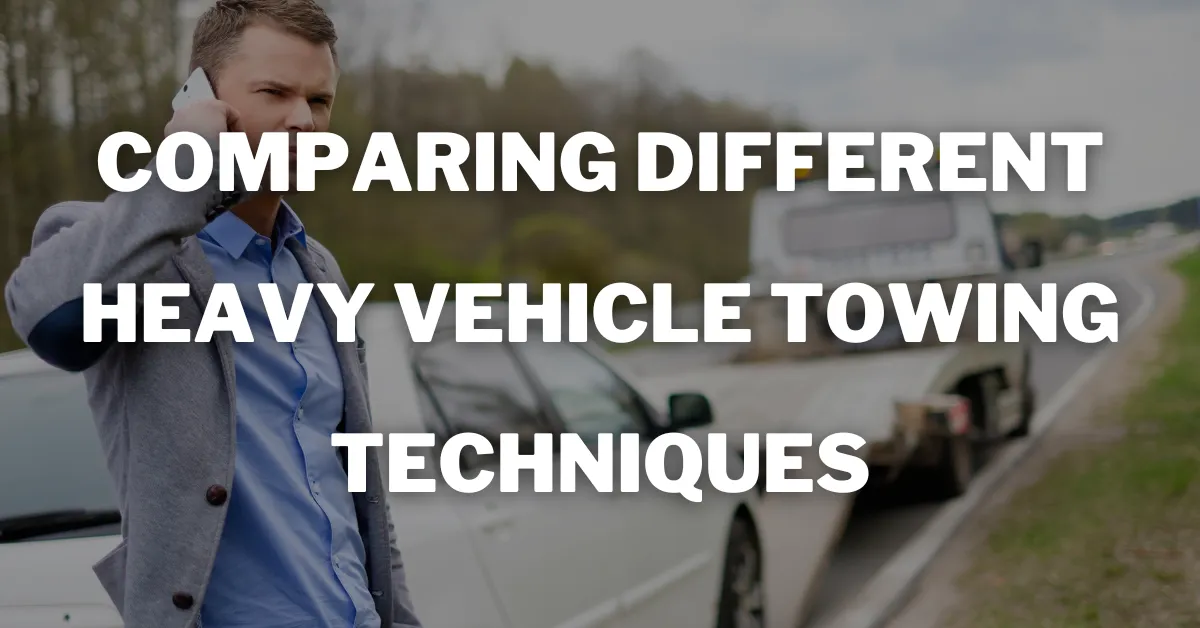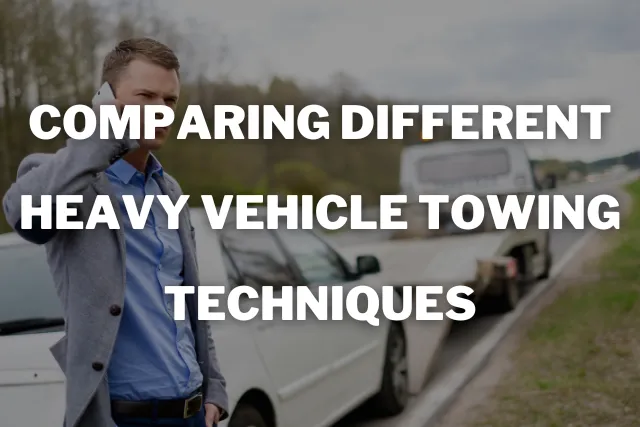
Heavy Vehicle Towing Techniques: When a truck, bus, RV, or piece of construction equipment needs to be moved, it’s referred to as heavy vehicle towing. Specialised towing equipment is used in this operation. Failures, collisions, or other circumstances may render these cars unusable. Heavy vehicle towing safely and effectively usually calls for specialised tow trucks with hydraulic systems, strong winches, and other equipment.
It’s vital to prevent additional harm to the car being towed and to ensure the safety of other drivers as well as the towing operators. To guarantee appropriate handling and transportation, regulations and safety requirements control the heavy vehicle towing methods.
Importance of Different Heavy Vehicle Towing Techniques
1. Off-Road Recovery: Heavy vehicles towing frequently operate in rough terrain or off-road conditions, where conventional towing methods might not be enough. Using specialised tools like winches, recovery straps, and off-road recovery vehicles, off-road recovery procedures help recover stranded or trapped cars from difficult terrain.
2. Adjusting for Load Shift: During transportation, large or uneven loads carried by heavy trucks may cause load shifts that compromise the stability and safety of the heavy vehicle towing. Using specialist equipment, load shift correction procedures distribute or secure the load to reestablish vehicle balance and avoid accidents when towing.
3. Rotator Towing: In order to lift and tow large cars from a variety of angles, rotator trucks are outfitted with revolving booms that resemble cranes. This method works especially well for rescuing completely wrecked or overturned cars as well as for getting into cars in tight spots where conventional towing techniques are impractical.
Why we need Heavy Vehicle Towing Techniques
Techniques for towing heavy vehicles towing are crucial for a number of reasons:
1. Safety & Security: If heavy vehicles towing become stalled on the road, there are serious threats to public safety. Techniques for towing guarantee the secure extraction of these cars, lowering the risk of mishaps or additional harm.
2. Flow of Traffic: On roads and highways, disabled heavy vehicles towing may cause traffic jams. By effectively removing these impediments, towing methods reduce traffic jams and disturbances.
3. Legal Compliance: When towing large cars, it’s frequently necessary to abide by rules and laws pertaining to the transportation of automobiles. Following these rules is ensured by using the right towing procedures, which helps to prevent penalties and legal issues.
4. Protection of Assets: Towing techniques serve as a safeguard against additional damage to heavy vehicles, which are important assets during transportation. Using the right towing technique saves more damage to the car’s body, cargo, and mechanical parts.
5. Emergency Reaction: Towing tactics facilitate quick reaction and recovery in the event of heavy car crashes, breakdowns, or other emergencies. This enables the affected cars to be relocated out of danger as soon as possible.
Different Heavy Vehicle Towing Techniques with its Advantages
1. Flatbed Towing
The practice of moving automobiles via flatbed towing involves utilising a flatbed truck with a hydraulic bed that can be lowered to the ground to facilitate effortless loading and unloading. This method is frequently employed for long-distance transportation of seriously harmed, disabled, or non-running vehicles.
In flatbed towing, the car is driven onto the flatbed truck’s platform or, in the event that it cannot move on its own, is pulled onto the bed by a winch. Once locked, the flatbed is hoisted to its starting position, and the car is fastened firmly using chains or straps to keep it from moving while being transported.
Advantages of Flatbed Towing
- Cars are positioned firmly on the bed’s level surface to reduce the possibility of additional damage occurring while being transported.
- Numerous types of vehicles, such as automobiles, trucks, SUVs, bikes, and even large machinery or equipment, can be loaded onto flatbeds.
- Flatbeds can be used for cars with restricted clearance or corroded tyres or axles since they are reasonably simple to load and unload.
2. Dolly Towing
Using a tow dolly, a compact trailer-like tool with two wheels and a moveable ramp is the process of towing something using the dolly method. While the back wheels stay on the ground and are free to roll, this method is usually applied to towing front-wheel-drive automobiles.
Once the tow dolly’s stages have been driven upon by the car to be towed, hitch mechanisms are used to fasten the dolly to the heavy vehicle towing.
The heavy vehicle towing is capable of carrying the car to its destination once it is firmly attached to the dolly tow. When the vehicle being towed rolls freely, its back wheels stay on the ground.
Advantages of Dolly Towing
- Dolly towing is a flexible choice for towing a variety of vehicles since it can be applied to front-wheel-drive vehicles of all sizes and forms.
- It makes it possible to tow automobiles with low clearance from the ground or those that are damaged or have mechanical problems.
- Compared with other towing techniques, dollies require less setup and are comparatively easy to use.
3. Wheel-lift Towing
Wheel lift towing is a technique for towing automobiles in which a hydraulic lifting system is used to raise the vehicle’s front or back wheels off the ground. The heavy vehicle towing other wheels stay on the ground and are free to roll while the elevated wheels are fastened to a tow truck.
In order to line the mechanism for lifting with the wheels that need to be lifted, the vehicle’s operator parks the towing vehicle near the car that has to be towed.
The tow vehicle can then transport the car to its intended location once it is safely fastened. The vehicle’s other wheels are free to roll on the ground, while the raised wheels are backed by the tow truck.
Advantages of Wheel-lift Towing
- Wheel lift towing is a flexible towing solution that works with a variety of cars, including those with front-wheel drive and rear-wheel drive.
- Unlike other towing techniques, wheel lift towing is comparatively simple, rapid, and requires little setup.
4. Rotator Towing
An advanced towing method known as “rotator towing” makes use of specialised tow trucks called “rotators,” which are fitted with revolving booms that resemble cranes. Because of their great mobility and 360-degree rotation, these rotators can precisely position and lift heavy vehicles towing at different angles and positions.
On a sturdy chassis, rotator heavy vehicle towing are outfitted with spinning booms driven by hydraulic power. These booms have increased lifting capacity and flexibility because of their extending, retracting, and rotating capabilities. To avoid movement during transport, the car is fastened to the tow truck through straps, chains, or other fastening devices after it has been raised and stabilised.
Advantages of Rotator Towing
- A variety of towing and recovery scenarios, from straightforward roadside assistance to intricate recovery operations.
- The boom’s 360-degree rotation capability minimises additional damage during recovery.
- Road clearance periods can be shortened, and traffic interruptions can be avoided with rotator towing.
5. Hook & Chain Towing
A tow truck fitted with a chain or cable fastened to a hook is used in the conventional technique of hook & chain towing, sometimes referred to as sling towing, to move automobiles. The car that needs to be towed proceeds to pull behind the heavy vehicle towing once this hook is fastened to its frame or axle.
The driver fastens a chain and strap featuring a hook onto the axle, frame, or other robust components of the car that have to be towed. The towing mechanism of the tow truck is then attached to this hook.
Advantages of Hook & Chain Towing
- Many types of cars, such as those with low ground clearance or harmed wheels or axles, can be towed using a hook and chain.
- It enables the towing of automobiles that are immobile or seriously damaged, and that cannot be pulled using conventional techniques.
6. Integrated Towing
A towing technique that combines the characteristics of a recovery heavy vehicle towing and a wrecker often referred to as a tow truck, is called integrated towing, integrated recovery, or integrated wrecker towing. To effectively manage a broad range of towing and recovery scenarios, these specialist trucks are outfitted with an array of capabilities and tools.
From basic roadside assistance to intricate operations for recovery involving overturned or severely damaged vehicles, integrated tow vehicles are built to handle a wide variety of towing and recovery activities. To stop the car from moving while being transported, straps, ropes, or other fastening methods are used to secure it to the tow truck after it has been raised and stabilised.
Advantages of Integrated Towing
- Integrated tow trucks are a useful and adaptable tool in the towing industry since they can manage a variety of towing and rescue scenarios.
- Integrated towing minimises road clearance requirements and minimises traffic disturbances.
- Even in difficult or dangerous circumstances, the sophisticated features & equipment that integrate tow trucks assist in guaranteeing safety.
How To Choose The Best Towing Technique
A number of variables must be taken into account while selecting the appropriate towing method, such as the kind of car to be towed, how it’s performing, and the distance to be towed. To assist you in selecting the ideal towing method, consider the following steps:
1. Examine the Car: Take the kind, dimensions, mass, and state of the car that needs to be towed into account. Find out whether it has all-wheel drive, rear-wheel drive, or front-wheel drive. Evaluate any mechanical problems or damage.
2. Analyse Road Conditions: Take into account the environment and state of the road where the towing is going to occur. For far-reaching towing on highways, for instance, flatbed towing might be more appropriate, whereas automobiles stuck in rough terrain might require off-road recovery methods.
3. Recognise Towing Distance: Take into account the required towing distance for the vehicle. While flatbed towing may be necessary for long-distance towing in order to provide extra stability and security, wheel lift or hooks and chain towing may be more practical for short-distance towing.
4. Think About Safety: Put the safety of other drivers and the towing operators first. Select a towing method that will provide stable attachment and safe transportation of the car while reducing the possibility of additional damage to the car being towed.
5. Evaluate Equipment Availability: Take into account the accessibility of towing machinery and knowledge in your region. Make sure that the resources at hand can be used to execute the selected towing method efficiently.
6. Consult Experts: Towing specialists or experts who can evaluate your needs and provide the most suitable towing approach should be consulted if you’re unclear about the most effective towing method for your particular situation.
7. Respect Regulations: Recognise any local laws that may limit or regulate the methods of towing that can be used. To prevent fines or legal issues, be sure the towing method you choose conforms with all applicable local rules and regulations.
Conclusion
To conclude, heavy vehicle towing methods are essential for the safe and effective transportation of enormous cars in a variety of circumstances. Different towing techniques offer unique benefits and are selected depending on variables such as vehicle type, situation, towing location, roadway conditions, and security considerations. These techniques can be used for retrieving disabled vehicles, removing obstacles from roadways, or transferring heavy gear.
For significantly damaged or crippled automobiles, flatbed towing offers a safe and damage-free long-distance transportation alternative, while wheel lift towing gives flexibility and availability for vehicles with restricted clearance. While hook-and-chain towing is still a feasible alternative in some instances, it has limitations. Rotator towing uses sophisticated technology to precisely lift and recover heavy vehicle towing in complex conditions.
In the end, determining the optimal heavy vehicle towing strategy entails evaluating the particular requirements and conditions of each towing scenario and picking the approach that guarantees the vehicle’s safe and effective transportation while limiting additional damage and preserving road safety.
FAQs:
Q1. How can I select the best towing method for my car?
A1. Take into account variables such as your car’s make, model, weight, and condition, the distance you need to tow, the state of the roads; and safety concerns.
Q2. What do you mean by integrated towing?
A2. The characteristics of a recovery heavy vehicle towing and a tow truck are combined in integrated towing. These specialist vehicles can effectively manage a variety of towing and recovery jobs because of their hydraulic expansions, winches, and other equipment.
Q3. When is it appropriate to use flatbed towing as opposed to wheel lift towing?
A3. For long-distance transport, automobiles with limited ground clearance, significant damage, or unique needs, flatbed towing is recommended. For fewer kilometres or situations where flatbed towing is impractical, wheel lift towing is appropriate.
Q4. When is towing with a hook and chain used?
A4. Sling towing, sometimes referred to as hook and chain towing, is usually utilised for short-distance towing of severely damaged vehicles. Towing a car behind a tow truck entails securing a chain or strap using a hook to the axle or frame of the car.
Q5. How is wheel lift towing accomplished?
A5. Using a hydraulic lifting system, wheel lift towing involves raising the vehicle’s front or rear wheels off the ground. While the other wheels are allowed to move freely on the ground, the elevated wheels are fastened to a tow vehicle.

Swen Weber is a dedicated expert in towing services and roadside assistance, offering valuable information and top-notch services to ensure prompt and reliable solutions for drivers in need.


